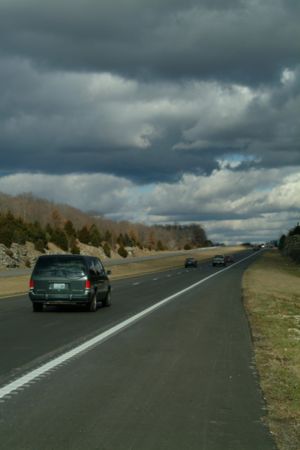231.4 Shoulder Width

231.4.1 Introduction
A shoulder is the portion of the roadway contiguous to the traveled way that accommodates stopped vehicles, emergency use, and provides lateral support of the subbase, base and pavement. Shoulders may be paved (with concrete or asphalt) or unpaved (with aggregate or soil).
Desirably, a vehicle stopped on the shoulder should clear the edge of the traveled way by at least 1 ft. (0.3 m), and preferably by 2 ft. (0.6 m). This preference has led to the preferred use of a 10 ft.(3.0 m) shoulder on major roadways. A shoulder at least 2 ft. (0.6 m) wide is encouraged on minor roadways.
On urban roadways, the shoulder is located inside a curb. Surfaced areas behind curbs located on urban roadways may be perceived as a sidewalk and thus subject to ADA requirements. Therefore, a surfaced area is not to be provided behind a mountable curb.
When roadside barriers, walls, or other vertical elements are present, the shoulder that is provided must be wide enough to ensure the vertical element is offset 2 ft. (0.6 m) from the edge of the useable shoulder. This is also true when guardrail is placed along the roadway.
Regardless of the width, a shoulder functions best when it is continuous. The full benefits of a shoulder are not realized unless it provides a driver with refuge at any point along the traveled way. A continuous shoulder provides a sense of security so all drivers making emergency stops will leave the traveled way. Although continuous shoulders are preferred, narrow shoulders and intermittent shoulders are still superior to no shoulders at all.
231.4.1.1 Rural Major Routes
For rural major routes, rehabilitation projects are to provide a minimum 4 ft. (1.2 m) shoulder. Always consider the context of the surrounding route. New construction projects will provide 10 ft. (3.0 m) shoulders.
231.4.1.2 Rural Minor Routes
The shoulder on rural minor roadways serves as structural support for the pavement and as additional width for the traveled way. This permits drivers meeting or passing other vehicles to drive on the edge of the roadway without leaving the surfaced area. Roads with a narrow traveled way, narrow shoulders and significant traffic tend to provide a poor level of service, have a higher crash rate, and need frequent and costly maintenance.
For rural minor routes, rehabilitation projects will provide a minimum 2 ft. (0.6 m) shoulder. Always consider the context of the surrounding route. New construction projects are to provide 4 ft. (1.2 m) shoulders.